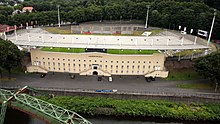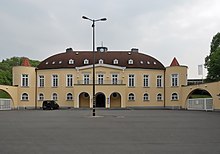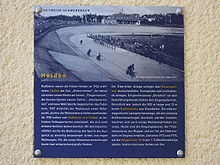Stadium at the zoo
| Stadium at the zoo | |
|---|---|

|
|
| The main stand of the Stadion am Zoo | |
| Data | |
| place | Hubertusallee 4 42117 Wuppertal Germany |
| Coordinates | 51 ° 14 '21 " N , 7 ° 6' 18" E |
| opening | 1924 |
| Renovations | 1993 2005 - approx. 04/2008 |
| surface | Natural grass |
| architect | Willkens & Nussbaum |
| capacity | 23,067 |
| Societies) | |
| Events | |
The Stadion am Zoo is a sports venue in the North Rhine-Westphalian city of Wuppertal in the zoo area , district Elberfeld-West . It has been a listed building since 1983 .
history

The initiator of the new stadium facility of the city of Elberfeld was the responsible councilor and civil engineering engineer Friedrich Roth. The stadium was designed by the Cologne architects Theo Nussbaum and Theo Willkens and completed within six months. The opening took place in October 1924 with great sympathy from the population. At that time it was one of the largest and most modern stadiums in West Germany , at that time the name " Bergisches Stadion " was common. This was due in particular to the imposing cycling track , which was integrated into the stadium between the cinder track and the spectator tiers.
The extremely fast concrete track - people talked about the fastest cycling track in Europe , maybe the whole world - allowed stalker races that were driven at an enormous pace. The Belgian world champion Victor Linart called it "the most beautiful track in Europe". Several world records in the standing race were achieved on the track, for example on October 24, 1955 the hour record over 96.016 kilometers of the Bochum cyclist Walter Lohmann . Standing races were held there until the 1950s, such as the standing competitions of the UCI Track World Championships in 1927 and the Track World Championships in 1954 . In the 1970s, however, the cycling track was partially demolished to allow additional spectator seats. Later, athletics events, particularly the international competition, also attracted the masses. Police parties as well as an outside bet from the TV show Wetten dass ..? also ensured a large number of visitors.
But in the end it was football that made the stadium famous. Wuppertaler SV has been able to call the venue as its own venue since 1954 . 35,000 spectators and more were not uncommon in what was then the 1st Bundesliga . In addition to FC Bayern Munich , FC Schalke 04 , VfB Stuttgart and Borussia Mönchengladbach , clubs such as SpVgg Erkenschwick , Rhenania Würselen , Westfalia Herne and VfL Witten , who, like the WSV, played in the top division at the time, the Oberliga West .
On March 20, 1938, the German national football team played against Luxembourg in front of 20,000 spectators (score 2: 1).
The official attendance record is 38,000 (Wuppertaler SV eV vs. Bayern Munich 1974). Unofficially, some events with up to 50,000 spectators are spoken of. For example, at a cup game between 1. FC Kaiserslautern and 1. FC Köln , benches were even set up on the cinder track to accommodate spectators.
Officially, the stadium at the zoo has a capacity of 28,300 spectators. For security reasons, a maximum of 25,300 will be admitted. Of these, 5000 seats are covered and 1500 seats are on the back straight.
At the beginning of the 1990s, the old (in danger of collapsing) main grandstand was replaced by an expensive new building (28 million DM). A large part of the costs devoured the preservation and restoration of the listed shield wall of the old main grandstand. Due to the requirements of the Upper Monument Authority, it is always very drafty in the stands and not necessarily dry at the edge when it rains. Next to the shield wall of the Berlin Olympic Stadium there is only this one. In 1993 a new main grandstand was opened.
Political events
In the run-up to the Reichstag elections in July 1932, Adolf Hitler and Joseph Goebbels spoke at two different mass rallies in the stadium at the Zoo. Up to 50,000 spectators attended Hitler's rally. Also in the stadium at the zoo, the KPD chairman Ernst Thälmann stood up to mobilize the communist voters. During the election campaign for the 1980 federal elections , Franz Josef Strauss spoke to 26,000 visitors.
today
In terms of sport, the stadium is used almost exclusively by Wuppertaler SV for home games. For a friendly against Bayern Munich, the stadium filled with 25,300 spectators in January 2004 and was therefore sold out.
It became problematic for the main user Wuppertaler SV at the end of January 2008, as they expected FC Bayern Munich again, but this time in the DFB-Pokal round of 16 . After the draw on ZDF , the club received tens of thousands of ticket requests. The conversion was not finished by the day of the match. Thus, the Wuppertaler SV moved to the Veltins Arena in Gelsenkirchen , which has around 61,500 seats, and thus significantly more than the stadium at the zoo (in the phase at that time: 16,500 seats).
The planned modernization
The cycling track and the standing bars were demolished and standing stands were created in their place directly behind the gates (on the former cinder track) for around 4800 standing places each. Originally, a capacity of 6700 spectators each was named for the stands; however, this number obviously related to the inclusion of the corner connections between the rear grandstands and a new opposite grandstand, which are to be realized in later stages. The estimated costs of the conversion to a football stadium, which began in 2006, amount to one million euros.
The plans for the first construction phase were announced on October 17, 2005 by the city administration, the sports and swimming pool office and the board of Wuppertaler SV. In November 2005 the city council and the monument authorities gave their approval for the project. A lot of earth was poured into the area behind the gates and the stands. At the same time, the playing field was widened by four to 72 meters in order to bring the existing main grandstand closer to the playing field. The measure should be completed on the last day of the 2006/07 season (against Kickers Emden (2: 4)), but the construction was stopped by the city administration due to financial complications. Construction continued in August 2007. Since the reason for the financial problems was the increase in the price of the concrete parts for the grandstand, the concrete parts are poured by unemployed Wuppertal people under professional supervision. The pouring of the concrete is also part of the training of the unemployed. The first grandstand was completed in mid-February 2008 and inaugurated at the home game of Wuppertaler SV against Rot Weiss Ahlen (0: 4 (0: 1)). The guest stand was inaugurated in mid-June 2008 in a test match against Bundesliga club 1. FC Köln (1: 1 (1: 1)).
These complications during the renovation of the stadium at the zoo did not occur for the first time. The modernization of the main stand from 1991 to 1993 was accompanied by similar financial problems.
The buildings are to be designed in such a way that both roofing and expansion and conversion into seating is possible. In a further construction phase (see above) it is planned to “close the gap” by building a similar stand for the back straight and thus complete the conversion into a pure football stadium.
By installing the new stands in the previous interior of the stadium - based on the model of the "new" central stadium in Leipzig - the exterior view of the stadium at the zoo will largely be preserved.
In the historic stadium restaurant, which has also been renovated, there is a sports shop and the Wuppertal Sports and Bathing Authority. The fan project Wuppertal , which was formerly located here, has now moved into new rooms in Tiergartenstrasse.
On December 18, 2017, a concept for a further expansion stage was published. In addition to closing the gap, this provides for a multifunctional building around the stadium. It is not only planned to roof the north stand, but also the remaining parts of the stand with a glass roof. The costs should amount to around 30 million euros. According to investor Thilo Küpper, one of the most beautiful stadiums in Germany is to be built.
literature
- Hella Nussbaum: The stadium at the zoo. In: Hella Nussbaum, Hermann J. Mahlberg (ed.): The zoo district in Wuppertal. Müller + Busmann, Wuppertal 2004, ISBN 3-928766-63-5 , p. 157 ff.
- Werner Skrentny (Hrsg.): The big book of the German football stadiums. Göttingen 2001, ISBN 3-89533-306-9 , p. 349 f.
- Peter Keller : Wuppertal stadiums. Erfurt 2003, ISBN 3-89702-539-6 .
See also
Web links
- Entry in the Wuppertal monument list
- stadionwelt.de: Stadium guide
- First phase of the stadium renovation successfully completed
- Fan initiative for the roofing of the north stand
- Zoostadion: The Wuppertal heart has been beating here since 1924 wz-newsline.de v. 4th June 2012
Individual evidence
- ↑ wuppertalersv.com: Stadion am Zoo - data and facts , accessed on February 19, 2009
- ↑ Ruth Meyer-Kahrweg : Architects, civil engineers, master builders, property developers and their buildings in Wuppertal Pies, Wuppertal 2003, ISBN 3-928441-52-3 .
- ^ Hella Nussbaum, Hermann J. Mahlberg: The Zooviertel in Wuppertal. Thiergarten, stadium and picturesque living around the fairy tale fountain 2004, ISBN 3-928766-63-5 .
- ↑ Julia Ströbel: The Bergisches Land in old photographs. Sutton, Erfurt 2003, ISBN 3-89702-638-4 .
- ↑ Zeitspurensuche.de , quoted from Westdeutsche Zeitung of August 11, 1989.
- ↑ WSVkurier.de ( page no longer available , search in web archives ) Info: The link was automatically marked as defective. Please check the link according to the instructions and then remove this notice. , The stadium at the zoo in Wuppertal.
- ↑ wuppertaler-rundschau.de: Big plans for the back straight Article from December 18, 2017


